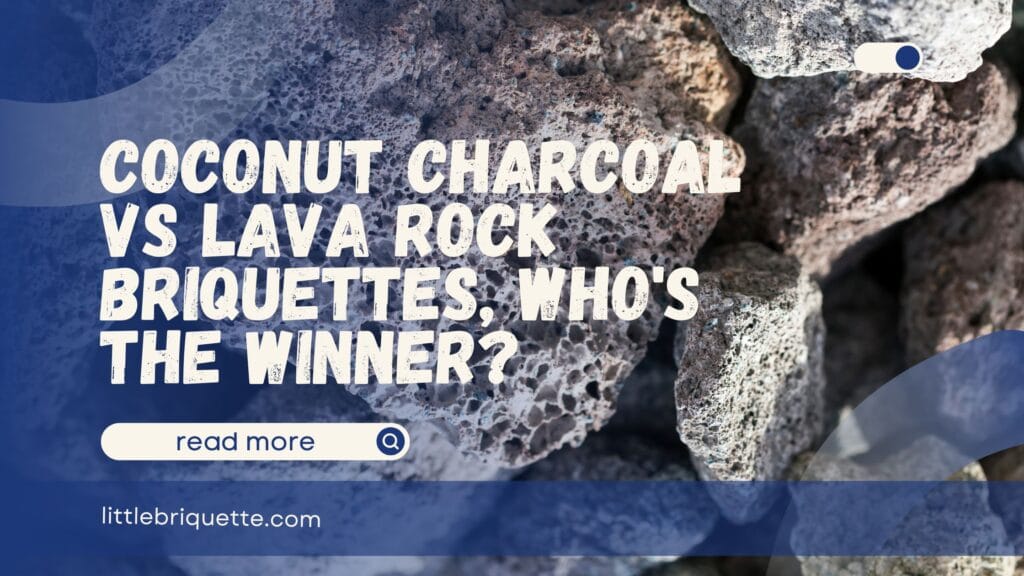In the world of grilling, choosing the right fuel can make a big difference, not only in the flavor of the food but also in convenience and environmental impact. This article will compare two popular fuel options: coconut charcoal briquettes and lava rock briquettes, each offering its own advantages.
Understanding the pros and cons of these two types of briquettes will help you choose the fuel that best suits your needs, whether for enjoying delicious grilled food or minimizing environmental impact. Let’s dive deeper and find out which one deserves to be called the winner in the grilling world!
What is Coconut Charcoal?
Coconut charcoal is a type of charcoal made from coconut shells, which are a natural and renewable resource. The process of making coconut charcoal begins with collecting cleaned coconut shells, which are then transformed into charcoal through a process called pyrolysis (heating without oxygen). In this process, the coconut shells are burned under controlled conditions at high temperatures to remove non-carbon elements and produce a dense, strong charcoal. This process results in charcoal with a high carbon content, making it more efficient in generating heat.
Coconut charcoal has several advantages that set it apart from regular charcoal. One of the key benefits is cleaner burning, as it produces little smoke and virtually no odor, making it an ideal choice for outdoor grilling or even indoor grilling with proper ventilation. Additionally, coconut charcoal burns at higher temperatures and lasts longer, allowing the grill to cook for extended periods without the need for frequent fuel replenishment. Since it is made from natural and renewable materials, coconut charcoal is also more environmentally friendly compared to wood charcoal, which is often produced from deforestation.
What are Lava Rock Briquettes?
Lava rock briquettes are made from natural lava stones found in volcanic regions. These lava stones have a porous texture that allows for even heat distribution. The process of making lava rock briquettes begins with cutting and shaping the lava stones into small sizes suitable for grilling. The stones are then heated at high temperatures to ensure optimal quality and durability. Lava rock briquettes do not need to be ignited like charcoal, as the natural properties of the lava stones allow them to absorb and retain heat for long periods, making them a durable and efficient option.
One of the main advantages of lava rock briquettes is their ability to evenly distribute heat, which helps reduce hot spots on the grill. This makes the cooking process more consistent, ideal for grilling meat, vegetables, or other foods. Lava rock briquettes are also highly durable and can be reused multiple times as long as the grill is maintained properly. Additionally, they do not produce excessive smoke or uncontrolled flames, making them safer and more convenient to use. The sustainability of lava rocks adds extra value, as the stones do not need to be replaced after every grilling session.
Read Also: Getting Know Ceramic Charcoal Briquettes, Eco-Friendly Solution
Coconut Charcoal vs Lava Rock Briquettes
Both coconut charcoal and lava rock briquettes, as recent innovations in grilling fuel, have their own unique advantages and drawbacks. Here’s a comparison between the two.
Performance Comparison Coconut Charcoal vs Lava Rock Briquettes

Coconut charcoal and lava rock briquettes differ significantly in terms of durability and longevity. Coconut charcoal tends to burn faster, meaning that while it can generate high heat quickly, it burns out more quickly and needs to be replenished more frequently during long grilling sessions. This makes coconut charcoal ideal for quick grilling, such as for steaks or burgers, but it requires more attention if used for slow cooking over longer periods.
On the other hand, lava rock briquettes are much more durable. They are designed for repeated use and can last much longer, even over several grilling sessions. Lava rocks retain heat for longer and distribute it evenly, making them more efficient in maintaining consistent temperatures during longer grilling times.
In terms of temperature and heat control, coconut charcoal can reach higher temperatures quickly, making it a great option for high-temperature cooking, such as searing meat. However, because it burns faster, these high temperatures tend to drop more quickly. Lava rock briquettes, while they do not reach temperatures as high as coconut charcoal, excel in maintaining a consistent heat.
Lava rocks distribute heat evenly and can maintain stable temperatures longer, making them ideal for slower, more even grilling. When it comes to flavor impact, coconut charcoal is better at imparting a clean, smoky flavor with minimal excess smoke, which is often preferred by grillers looking for a pure taste in their food. Lava rock briquettes, on the other hand, are more about heat retention and although they don’t add significant flavor, they allow food to cook in a more consistent and stable manner.
Health and Safety Benefits

Coconut charcoal has an advantage when it comes to safety, especially when used indoors or in areas with limited ventilation. The combustion of coconut charcoal produces very little smoke and almost no odor, making it a cleaner and safer option compared to traditional charcoal. Its cleaner burn means that fewer harmful particles or carbon monoxide are released in significant amounts, which could be a health risk in enclosed spaces without proper ventilation. This makes coconut charcoal a safer choice, especially for grillers who want to avoid respiratory issues or other health problems caused by excessive smoke.
On the other hand, lava rock briquettes also have safety benefits, as they produce little smoke and are less likely to cause excessive flames. Lava rocks are highly stable and not easily flammable, which reduces the risk of sudden fires or accidents. Additionally, lava rock briquettes don’t require much attention during use, as the heat they emit is relatively stable and even, allowing the griller to focus on the cooking process.
While no harmful emissions are produced, lava rock briquettes should still be used cautiously in open areas to avoid fire hazards. Overall, both options are relatively safe for grilling, with lava rock being a bit easier to handle without worrying about excessive smoke or uncontrolled flames.
Read Also: Embers Charcoal Briquettes, A Long-Lasting Burning Solution
Certified Coconut Charcoal Briquette Production Center
For the optimal and enjoyable grilling experience, you can try fuel made from coconut shells. This coconut shell-based fuel offers excellent grilling quality and delicious cooking results. You can obtain it at Little Briquette, a certified coconut charcoal briquette factory, by contacting the admin number here.

